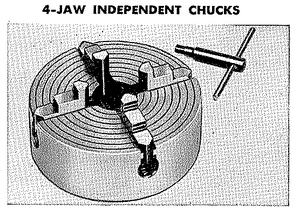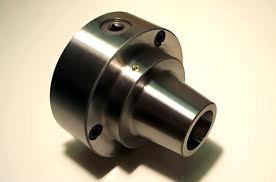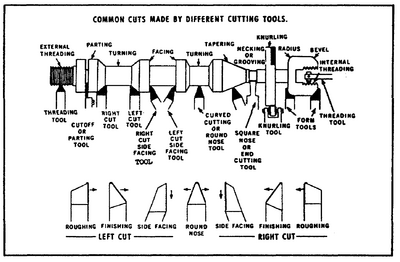Manual lathe (Logan)
Not to be confused with CNC Lathe, a numerically controlled lathe.
Skip to Changeovers or Types of tools}
See Main Article:Machine_Shop_(General)}}
Lathes are used to manufacture round components, as opposed to flat or rectangular items, which are made on the mills. Our Logan lathes were acquired in 1960. They are due for replacement when funds become available. New lathes would have variable speed spindles and digital readout systems.[1]
Anatomy[edit | edit source]
There are many types of lathes, some with more components than others, but they all have a headstock, tailstock, and carriage.
Headstock[edit | edit source]
The main part of the lathe is referred to as the headstock which typically includes a spindle and drive plate, high and low speed selector(s) (See: Changing Between High and Low Speeds), spindle speed selector (See: Changing speed of manual lathe) and tapping/power feed speed controls (See: Changing Tapping and Power Feed Speed). A chuck, which holds the working material, is attached to the drive plate.
Chuck[edit | edit source]
There are three main types of chucks used on a lathe. A three jaw chuck which is the most common and most often used because of its ability to clamp material quickly. Most lathes will have three jaw chucks in at least two sizes, a larger size for everyday use and a smaller high speed chuck which is capable of higher speeds. The second type of chuck is a four jaw chuck. Four jaw chucks are used for the holding of non-round material, and non-concentric turning. Unlike a three jaw chuck, all four jaws are adjusted independently, and such a dial indicator must be used when chucking material (See: Zeroing Parts in Four Jaw Chuck). The third type of chuck is a collet chuck. Collet chucks are used when greater contact area is need for holding the part, as well as having the advantages of quicker chucking when producing multiple copies of the same part. For more information on chucks, see Swapping Lathe Chuck
Jaws[edit | edit source]
There are two main types of jaws, the standard jaw, and the soft jaw. Standard jaws typically have a 'wide side' used for general purpose turning which provide a large clamping surface over a wide diameter range. The jaws often can be removed and reinserted backwards so that the 'stepped side' of the jaw is facing inwards. While this is true of the CNC HAAS, the Logan's have a second set of jaws, kept in the cabinet. Soft jaws start out as aluminum blanks that can be machined to an exact diameter to result in excellent contact surface with reduced possibility of marking parts. While soft jaws require more setup time their advantages can be critical.
Tailstock[edit | edit source]
The tailstock is an assembly which is capable in moving in the z direction and is typically composed of a telescoping shaft which accepts tapered collets, a lock handle to fix the position, and a handle for actuation. The tailstock is commonly used for drilling operations, as well as holding long work pieces for stabilization purposes in a live/dead center.
Carriage[edit | edit source]
The carriage is the primary means of working on a lathe and is typically comprised of the cross feed, x-feed, threading dial indicator, threading controls (See: Cutting Threads on a Manual Lathe), power feed controls (See: Using the Power Controls), a tool changer (See: Changing Lathe Tools).
Overview of Lathe Tools[edit | edit source]
Put below into a table (with links if necessary:
- Boring Bar
- Face off tool
- Parting tool
- Turning tool
- Threading tools
- Radius Tools
- what else?
Lathe Changeovers[edit | edit source]
- Changing the chuck
- Adjusting speed (including low and high gears)
- Setup for power feed and threads
- Using the magnetic dial indicators
- Use of tailstock
References[edit | edit source]
- ↑ Russ Porter






